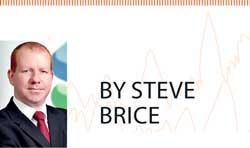03 Feb 2016 - {{hitsCtrl.values.hits}}

Global markets have had a rather rocky start to the year, to put it mildly. An indicator of global stocks has fallen 19 percent from their record highs in May 2015 amid a broad-based sell-off in risk assets. An indicator of emerging markets stocks is down 35 percent from last year’s peaks. It’s time for investors to face some inconvenient truths and adapt their portfolios accordingly.
The first inconvenient truth is that economic turning points matter.
Global equity markets on average peak approximately six to seven months prior to the start of a US recession and bonds normally bottom around six months prior to a US recession. Therefore, getting the timing of when the US falls into a recession is critical to investing – unless, of course, one believes that the huge change in sources of global gross domestic product (GDP) and GDP growth (as a result of the rise of China) makes the above statistics irrelevant. The second inconvenient truth is that economists have a poor record of predicting recessions. While equity markets famously predict more recessions than actual occurrences (think about the number of times equities fall more than 20 percent into a technical bear market but are not followed by an economic recession), economists predict fewer and are usually way too late. The best example was the 2001 recession. Economists that year started predicting a US recession after the 9-11 terrorist attacks in the US (i.e. in September 2001). Yet, according to the National Bureau of Economic Research, the entity responsible for dating US recessions, the recession had already started six months earlier - in March 2001. In fact, the recession was over by November, two months after economists started worrying about it. It would be nice if this was an aberration, but the 2007 experience reinforces the challenges economists face when it comes to predicting recessions. The third inconvenient truth follows the second – given the economic uncertainty, investors need to adopt a probabilistic, as opposed to a deterministic, approach. This makes diversification increasingly important.
Nobody knows with certainty what is going to happen. In the US, looking at the unemployment rate can help give an idea about the probability of a recession - the lower the unemployment rate, the higher the risk of a recession. At current levels, the probability of a recession over the next 12 months is gauged at around 10 to 20 percent. The US services sector is thriving on the back of record low borrowing costs, low energy prices and strong consumption. And yet, the manufacturing sector is contracting as the strong US dollar hurts exports and makes imported goods more competitive, even as falling oil prices are increasing bankruptcies in the energy sector. The tussle between the two forces in the US is likely to continue causing volatility in the markets, as will China’s ongoing shift towards a consumption-driven economy and its efforts to make its currency more responsive to market dynamics. Now, of course, these are just a few inputs out of many potential factors that make the outlook uncertain. For instance, rising tensions in the Middle East could lead to conflict in a major oil-producing region, resulting in a sharp oil price spike and a cut in discretionary spending. For now, oil prices are moving in the opposite direction, of course. However, one lesson from the past 18 months is that things can change quickly, especially in commodity markets.
So what does this mean for investors?
There is a natural tendency among investors to only buy assets that have been rising in value for a period of time. The problem is nobody knows with any degree of certainty whether they will continue to appreciate. Our central scenario is for the US economy to continue its expansion for an additional 18 to 24 months, Europe and Japan to accelerate modestly and China to manage a soft-landing of its economy. Therefore, we remain comfortable with a significant exposure to global equities. However, there are always risks that economy does not pan out as predicted. And, even if we are right, as the US economic cycle matures, equity returns are likely to see significant bouts of volatility. Therefore, it is time for investors to seriously consider seeking protection. Diversification across various uncorrelated asset classes, such as equities, high-grade bonds and alternative strategies, is a time-tested principle that shields investors from downturns in any one particular asset class. However, long-drawn equity bull markets - such as the one we have had for the last six years - tend to lull investors into complacency. The recent bout of market volatility is a good reminder of the virtues
of diversification.
(Steve Brice is Chief Investment Strategist at Standard Chartered Bank’s Group Wealth
Management unit)
26 Nov 2024 2 hours ago
26 Nov 2024 2 hours ago
26 Nov 2024 2 hours ago
26 Nov 2024 3 hours ago
26 Nov 2024 4 hours ago